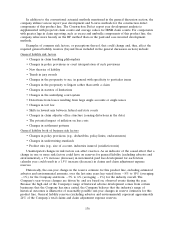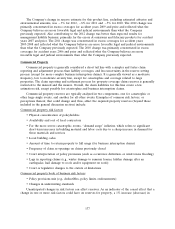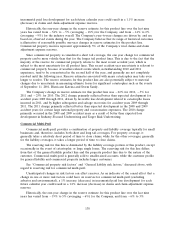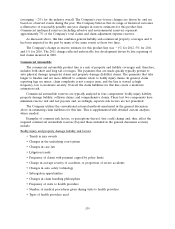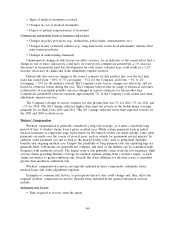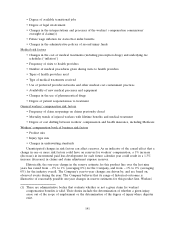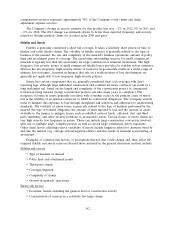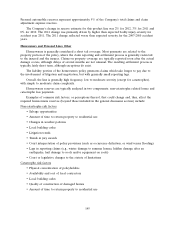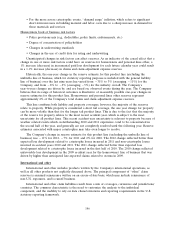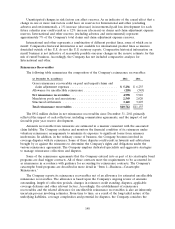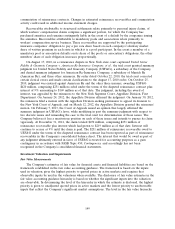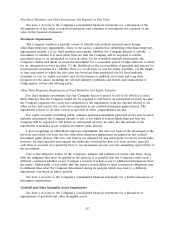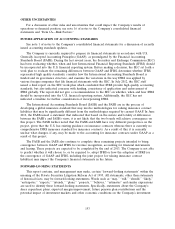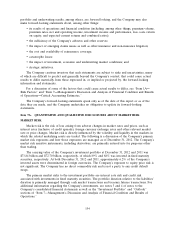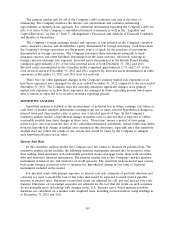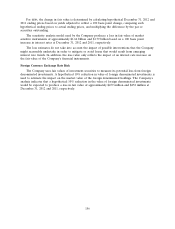Travelers 2012 Annual Report Download - page 158
Download and view the complete annual report
Please find page 158 of the 2012 Travelers annual report below. You can navigate through the pages in the report by either clicking on the pages listed below, or by using the keyword search tool below to find specific information within the annual report.
• For the more severe catastrophic events, ‘‘demand surge’’ inflation, which refers to significant
short-term increases in building material and labor costs due to a sharp increase in demand for
those materials and services
Homeowners book of business risk factors
• Policy provisions mix (e.g., deductibles, policy limits, endorsements, etc.)
• Degree of concentration of policyholders
• Changes in underwriting standards
• Changes in the use of credit data for rating and underwriting
Unanticipated changes in risk factors can affect reserves. As an indicator of the causal effect that a
change in one or more risk factors could have on reserves for homeowners and personal lines other, a
1% increase (decrease) in incremental paid loss development for each future calendar year could result
in a 1.1% increase (decrease) in claims and claim adjustment expense reserves.
Historically, the one-year change in the reserve estimate for this product line (excluding the
umbrella line of business, which for statutory reporting purposes is included with the general liability
line of business) over the last nine years has varied from 31% to 3% (averaging 11%) for the
Company, and from 8% to 2% (averaging 5%) for the industry overall. The Company’s
year-to-year changes are driven by, and are based on, observed events during the year. The Company
believes that its range of historical outcomes is illustrative of reasonably possible one-year changes in
reserve estimates for this product line. Homeowners and personal lines other reserves represent
approximately 4% of the Company’s total claims and claim adjustment expense reserves.
This line combines both liability and property coverages; however, the majority of the reserves
relate to property. While property is considered a short tail coverage, the one year change for property
can be more volatile than that for the longer tail product lines. This is due to the fact that the majority
of the reserve for property relates to the most recent accident year, which is subject to the most
uncertainty for all product lines. This recent accident year uncertainty is relevant to property because of
weather related events which, notwithstanding 2010 and 2011 experience, tend to be concentrated in
the second half of the year, and generally are not completely resolved until the following year. Reserve
estimates associated with major catastrophes may take even longer to resolve.
The Company’s change in reserve estimate for this product line (excluding the umbrella line of
business) was 11% for 2012, 7% for 2011 and 2% for 2010. The 2012 change reflected better than
expected loss development related to catastrophe losses incurred in 2011 and non-catastrophe losses
incurred in accident years 2010 and 2011. The 2011 change reflected better than expected loss
development related to catastrophe losses incurred in the first half of 2010. The 2010 change reflected
unfavorable loss development in the 2009 accident year for the homeowners’ line of business that was
driven by higher than anticipated late-reported claims related to storms in 2009.
International and other
International and other includes products written by the Company’s international operations, as
well as all other products not explicitly discussed above. The principal component of ‘‘other’’ claim
reserves is assumed reinsurance written on an excess-of-loss basis, which may include reinsurance of
non-U.S. exposures, and is runoff business.
International and other claim liabilities result from a mix of coverages, currencies and jurisdictions/
countries. The common characteristic is the need to customize the analysis to the individual
component, and the inability to rely on data characterizations and reporting requirements in the U.S.
statutory reporting framework.
146


